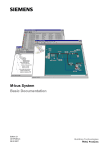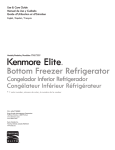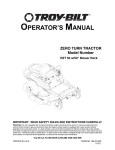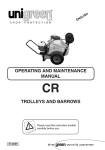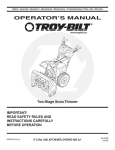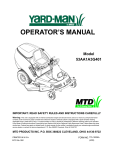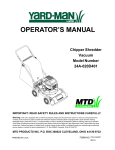Download Troy-Bilt LS338 User's Manual
Transcript
Operator’s Manual Log Splitter Model LS338 IMPORTANT: Read safety rules and instructions carefully before operating equipment. Warning: This unit is equipped with an internal combustion engine and should not be used on or near any unimproved forestcovered, brush-covered or grass-covered land unless the engine’s exhaust system is equipped with a spark arrester meeting applicable local or state laws (if any). If a spark arrester is used, it should be maintained in effective working order by the operator. In the State of California the above is required by law (Section 4442 of the California Public Resources Code). Other states may have similar laws. Federal laws apply on federal lands. A spark arrester for the muffler is available through your nearest engine authorized service dealer or contact the service department, P.O. Box 361131 Cleveland, Ohio 44136-0019. TROY-BILT LLC. P.O. BOX 361131 CLEVELAND, OHIO 44136-0019 PRINTED IN U.S.A. FORM NO. 769-00089A.fm (10/2002) TABLE OF CONTENTS Content Page Important Safe Operation Practices................................................................... 3 Assembling Your Log Splitter ............................................................................ 5 Know Your Log Splitter ...................................................................................... 9 Operating Your Log Splitter ............................................................................... 10 Adjusting Your Log Splitter ................................................................................ 12 Maintaining Your Log Splitter............................................................................. 12 Storing Your Log Splitter.................................................................................... 14 Troubleshooting................................................................................................. 14 Parts List............................................................................................................ 16 FINDING MODEL NUMBER This Operator’s Manual is an important part of your new log splitter. It will help you assemble, prepare and maintain the unit for best performance. Please read and understand what it says. Before you start assembling your new equipment, please locate the model plate on the equipment and copy the information from it in the space provided below. The information on the model plate is very important if you need help from our Customer Support Department or an authorized dealer. • You can locate the model number by standing behind the unit and looking down at the hydraulic tank. A sample model plate is explained below. For future reference, please copy the model number and the serial number of the equipment in the space below. Copy the model number here: www.troybilt.com TROY-BILT LLC P. O. BOX 3 6 1 1 3 1 CLEVELAND, OH 44136 330-558-7220 866-840-6483 Copy the serial number here: ENGINE INFORMATION The engine manufacturer is responsible for all engine-related issues with regards to performance, powerrating, specifications, warranty and service. Please refer to the engine manufacturer’s Owner’s/Operator’s Manual packed separately with your unit for more information. CALLING CUSTOMER SUPPORT If you have difficulty assembling this product or have any questions regarding the controls, operation or maintenance of this unit, please call 1-866-840-6483 or 1-330-558-7220 to reach a Customer Support representative. Please have your unit’s model number and serial number ready when you call. See previous section to locate this information. You will be asked to enter the serial number in order to process your call. For more details about your unit, visit our website at www.troybilt.com 2 SECTION 1: IMPORTANT SAFE OPERATION PRACTICES WARNING: This symbol points out important safety instructions which, if not followed, could endanger the personal safety and/or property of yourself and others. Read and follow all instructions in this manual before attempting to operate this machine. Failure to comply with these instructions may result in personal injury. When you see this symbol - heed its warning. WARNING: Engine exhaust, some of its constituents, and certain vehicle components contain or emit chemicals known to the State of California to cause cancer, birth defects or other reproductive harm. DANGER: This machine was built to be operated according to the rules for safe operation in this manual. As with any type of power equipment, carelessness or error on the part of the operator can result in serious injury. This machine is capable of amputating hands and feet and throwing objects. Failure to observe the following safety instructions could result in serious injury or death. General Practices 1. 2. 3. 4. 5. 6. 7. 8. 9. 5. 6. 7. Read, understand, and follow all instructions on the machine and in the manual(s) before attempting to assemble and operate. Keep this manual in a safe place for future and regular reference and for ordering replacement parts. Be familiar with all controls and proper operation. Know how to stop the machine and disengage them quickly. Never allow children under 16 years to operate this machine. Children,16 years and over, should read and understand instructions and safety rules in this manual and should be trained and supervised by a parent. Never allow adults to operate this machine without proper instruction. Many accidents occur when more than one person operates the machine. If a helper is assisting in loading logs, never activate the control until the helper is a minimum of 10 feet from the machine. Keep bystanders, helpers, pets, and children at least 20 feet from the machine while it is in operation. Never allow anyone to ride on this machine. Never transport cargo on this machine. Hydraulic log splitters develop high fluid pressures during operation. Fluid escaping through a pin hole opening can penetrate your skin and cause blood poisoning, gangrene, or death. Give attention to the following instructions at all times: a. Do not check for leaks with your hand. b. Do not operate machine with frayed, kinked, cracked, or damaged hoses, fitting, or tubing. c. Stop the engine and relieve hydraulic system pressure before changing or adjusting fittings, hoses, tubing, or other system components. d. Do not adjust the pressure settings of the pump or valve. Leaks can be detected by passing cardboard or wood, while wearing protective gloves and safety glasses, over the suspected area. Look for discoloration of cardboard or wood. If injured by escaping fluid, see a doctor immediately. Serious infection or reaction can develop if proper medical treatment is not administered immediately. Keep the operator zone and adjacent area clear for safe, secure footing. 8. If your machine is equipped with an internal combustion engine and it is intended for use near any unimproved forest, brush, or grass covered land, the engine exhaust should be equipped with a spark arrester. Make sure you comply with applicable local, state, and federal codes. Take appropriate firefighting equipment with you. 9. This machine should be used for splitting wood only, do not use it for any other purpose. 10. Follow the instructions in the manual(s) provided with any attachment(s) for this machine. Preparation 1. 2. 3. 4. 5. 6. 7. 8. 9. 3 Always wear safety shoes or heavy boots. Always wear safety glasses or safety goggles during operating this machine. Never wear jewelry or loose clothing that might become entangled in moving or rotating parts of the machine. Make sure machine is on level surface before operating. Always block machine to prevent unintended movement, and lock in either horizontal or vertical position. Always operate this machine from the operator zone(s) specified in the manual. Logs should be cut with square ends prior to splitting. Use log splitter in daylight or under good artificial light. To avoid personal injury or property damage use extreme care in handling gasoline. Gasoline is extremely flammable and the vapors are explosive. Serious personal injury can occur when gasoline is spilled on yourself or your clothes which can ignite. Wash your skin and change immediately. a. Use only an approved gasoline container. b. Extinguish all cigarettes, cigars, pipes, and other sources of ignition. c. Never fuel machine indoors. d. Never remove gas cap or add fuel while the engine is hot or running. e. Allow engine to cool at least two minutes before refueling. f. Never overfill the fuel tank. Fill tank to no more than 1/2 inch below bottom of filler neck to provide space for fuel expansion. g. Replace gasoline cap and tighten securely. h. If gasoline is spilled, wipe it off the engine and i. j. Maintenance and Storage equipment. move machine to another area. Wait 5 minutes before starting the engine. Never store the machine or fuel container inside where there is an open flame, spark or pilot light as on a water heater, space heater, furnace, clothes dryer or other gas appliances. Allow machine to cool 5 minutes before storing. 1. 2. Operation 1. 2. 3. 4. 5. 6. 7. 8. 9. 10. 11. 12. 13. 14. 15. 16. 17. 3. Before starting this machine, review the “Safety Instructions”. Failure to follow these rules may result in serious injury to the operator or bystanders. Never leave this machine unattended with the engine running. Do not operate machine while under the influence of alcohol, drugs, or medication. Never allow anyone to operate this machine without proper instruction. Always operate this machine with all safety equipment in place and working. Make sure all controls are properly adjusted for safe operation. Do not change the engine governor settings or overspeed the engine. The governor controls the maximum safe operating speed of the engine. When loading a log, always place your hands on the sides of the log, not on the ends, and never use your foot to help stabilize a log. Failure to do so, may result in crushed or amputated fingers, toes, hand, or foot. Use only your hand to operate the controls. Never attempt to split more than one log at a time unless the ram has fully extended and a second log is needed to complete the separation of the first log. For logs which are not cut square, the least square end and the longest portion of the log should be placed toward the beam and wedge, and the square end placed toward the end plate. When splitting in the vertical position, stabilize the log before moving the control. Split as follows: a. Place log on the end plate and turn until it leans against the beam and is stable. b. When splitting extra large or uneven logs, the log must be stabilized with wooden shims or split wood between the log and end plate or ground. Always keep fingers away from any cracks that open in the log while splitting. They can quickly close and pinch or amputate your fingers. Keep your work area clean. Immediately remove split wood around the machine so you do not stumble over it. Never move this machine while the engine is running. This machine should not be towed on any street, highway or public road without checking the existing federal, state, or local vehicle requirements. Any licensing or modifications such as taillights, etc., needed to comply, is the sole responsibility of the purchaser. If a “Statement of Origin” is required in your state, see your local dealer. Do not tow machine faster than 45mph. See Transporting the Log Splitter section in this manual for proper towing instructions once all federal, local, or state requirements are met. 4. 5. 6. 7. 8. 9. Stop the engine, disconnect the spark plug and ground it against the engine before cleaning, or inspecting the machine. Stop the engine and relieve hydraulic system pressure before repairing or adjusting fittings, hoses, tubing, or other system components. To prevent fires, clean debris and chaff from the engine and muffler areas. If the engine is equipped with a spark arrester muffler, clean and inspect it regularly according to manufacturers instructions. Replace if damaged. Periodically check that all nuts and bolts, hose clamps, and hydraulic fittings are tight to be sure equipment is in safe working condition. Check all safety guards and shields to be sure they are in the proper position. Never operate with safety guards, shields, or other protective features removed. The pressure relief valve is preset at the factory. Do not adjust the valve. Never attempt to move this machine over hilly or uneven terrain without a tow vehicle or adequate help. For your safety, replace all damaged or worn parts immediately with original equipment manufacturer’s (O.E.M.) parts only. “Use of parts which do not meet the original equipment specifications may lead to improper performance and compromise safety!” Do not alter this machine in any manner, alterations such as attaching a rope or extension to the control lever, or adding to the width or height of the wedge may result in personal injury. Your Responsibility Restrict the use of this power machine to persons who read, understand and follow the warnings and instructions in this manual and on the machine. Some of the safety labels are reproduced here. Always follow directions on safety labels found on your equipment. 4 SECTION 2: ASSEMBLING YOUR LOG SPLITTER Unpacking from Crate Before Assembling • Pry top, sides, and ends off the crate. Set panels aside to avoid tire puncture or personal injury. Remove and discard plastic bag that covers unit. Remove any loose parts if included with unit (i.e., operator’s manual, etc.) Cut and remove straps which secure parts to bottom of crate. Unbolt any remaining parts which may be bolted to the bottom of the crate. • WARNING: Use extreme caution while • unpacking this machine. Some components are very heavy and will require extra people or mechanical handling equipment to move. • • • • Disconnect spark plug wire and ground against the engine to prevent unintended starting of the log splitter. To locate the spark plug, please refer to the engine manual, shipped seperately with the unit. Attaching Beam Support/Latch Bracket The beam support is already attached to the tongue before shipping. If not, follow instructions below: Remove two hex bolts, lock washers, and hex nuts from the tongue. See Figure 2. Place the beam support/latch bracket on the tongue and secure with the hardware just removed. Tighten securely. Loose Parts 1. 2. 3. 4. 5. 6. 7. 8. 9. 10. 11. 12. Hex Bolts Reservoir Tank and Engine-Pump Assembly Engine-Pump Assembly Hardware Wedge, Beam and Cylinder Assembly Tongue Assembly Wheels Hitch Assembly Beam Support/Latch Bracket Log Cradle Brackets and Hardware Fenders Adjustable Jack Stand Assembly Tail Light Kit Hub Cap (2) Lock Washer Ton gue Hex Nut Figure 2 Log Cradle Tail Light Kit Beam Support/ Latch Bracket Attaching Jack Stand • Beam Support/ Latch Bracket • Hitch Assembly Remove four hex bolts, lock washers, and hex nuts that secure jack stand mounting brackets to the jack stand. See Figure 3. Place the jack stand halfway between beam support/latch bracket and end of tongue. Hex Bolts Mounting Brackets Wedge, Beam & Cylinder Assembly Tongue Assembly Jack Stand Wheel & Fender Assembly Ton gue Lock Washer Jack Stand Hex Nuts Figure 1 Lock Washer Figure 3 5 • • • Insert hex bolts through top holes in jack stand mounting brackets and holes in jack stand. Secure with lock washers and hex nuts. See Figure 3. Insert hex bolts through upper holes in the bottom of mounting brackets and jack stand. Secure with lock washers and hex nuts. See Figure 3. Insert cotter pins through slots in nuts and holes in axle and secure by bending the ends of the cotter pins in opposite directions. See Figure 5. Lock Washer Fender Hitch Assembly The hitch assembly is already attached to the tongue before shipping. If not, follow instructions below: • • Hex Bolt Remove the hardware from the hitch assembly and place the hitch on the end of the tongue. Insert hex bolt through flat washer, end of safety chain, spacer, and then rear hitch hole. Pivot the end of safety chain so it faces the ball end of hitch. See Figure 4. Flat Washer Cotter Pin • Flat Washer • Spacer • • • • Insert other spacer, safety chain, and flat washer on the other end of the hex bolt and secure with hex lock nut. See Figure 4. Insert hex bolt through the front hole of hitch and secure with flat washer and hex lock nut. Tighten both hex nuts to 23 ft-lbs. • • • Remove the hex nuts, lock washers, flat washers, and hex bolts from the side of tank. Determine the proper assembly holes in the fenders over the tires against the tank. Insert hex bolts through flat washers, holes in fenders, and tank. See Figure 5. Secure fender with lock washers and hex nuts. Tighten securely. Attaching the Tongue • Block up the reservoir tank assembly about eight to twelve inches. Remove and discard plastic shipping caps on the outside of the wheels. Remove the cotter pin, hex slotted nut, and flat washer from each axle. • • Remove two hex bolts, lock washers, and hex nuts on the front of the reservoir tank. See Figure 6. Place the tongue in position and secure with hardware just removed. Remove the reservoir tank from the blocks. Reservoir Tank NOTE: It is recommended that you polish the axles with emery cloth before you install the wheels. • The wheels should spin freely and there should be no side to side play. Place hub caps in position on wheels and tap on to the axle with a soft hammer or mallet. Attaching Fenders Attaching Wheels • Hex Slotted Nut circumstance is 30 psi. Equal tire pressure should be maintained at all times. Figure 4 • Wheel IMPORTANT: Maximum tire pressure under any Hitch Assembly Chain • Reservoir Tank Figure 5 Lock Nut Hex Bolt Flat Washer Hub Cap Ton gue Hex Bolt Hex Nut Place a wheel on each axle with the valve stem facing outward. See Figure 5. Place a flat washer on each axle and secure with hex slotted nut. Tighten slotted nut until snug and then back off approximately 1/3 turn or until one of the slots on the slotted nut lines up with the hole in the axle. Hex Bolts Tongue Hex Nuts Lock Washers Figure 6 6 Attaching Beam • • • • • Hex Nuts Engine Mounting Bracket For shipping purposes, the pressure hose is attached to the pump on the engine and to the control valve on the cylinder. Disconnect the pressure hose from the adapter on the pump. Stand the wedge, beam, and cylinder assembly upright with cylinder toward the top. An assistant may be helpful. Remove cotter pin and clevis pin from welded brackets on beam assembly and move the reservoir tank assembly in position against the beam. Insert clevis pin just removed through brackets on beam and reservoir tank assembly. Secure with cotter pin by bending the ends of the pin in opposite directions. Reservoir Tank Lock Washer Hex Bolts Pump Facing Out Figure 8 Attaching The Hoses Suction Hose • Cotter Pin Clevis Pin Brackets The suction is attached to the reservoir tank, beneath the engine mounting bracket. Loosen the hose clamp on the free end of the hose. Remove any protective insert from the end of the hose. See Figure 9. Pressure Hose Attached To Reservoir Tank Pump Hose Clamp Reservoir Tank Suction Hose Figure 9 Figure 7 • Attaching Engine-Pump Assembly • • • • Attached To Engine Place the engine and pump assembly in position on the engine mounting bracket with the pump facing out. See Figure 8. Align holes in base of engine with appropriate holes in engine mounting bracket. Secure the engine and pump assembly with four hex bolts, lock washers, and hex nuts packed with the Operator’s Manual. Secure with lock washers and hex nuts. Tighten to 14 ft-lbs. Remove the protective cap from the fitting on the bottom of the pump (some oil may flow from pump). Attach the end of the suction hose to the fitting on the bottom of the pump. Place the hose clamp at the base of the fitting and tighten securely. Pressure Hose • The pressure hose is attached to the control valve. Route the hose between the beam and the tongue. Secure the pressure hose to the adapter on the top of the pump. See Figure 9. Return Hose • 7 The return hose is attached to the top of the control valve. Loosen the hose clamp on the free end of the hose. Cut the securing strap. Remove any protective insert from the end of the hose. • • Remove the protective cap from the fitting on top of the filter head. Attach the end of the hose to the fitting on top of the filter. Place the hose clamp at the base of the fitting and tighten securely. See Figure 10. • Preparing the Log Splitter Attached To Cylinder Control Valve Insert four carriage bolts through the log cradle and cradle support brackets. Secure with lock washers and hex nuts. Tighten all carriage bolts and nuts. Repeat on the other side. • Hose Clamp • Lubricate the beam area where the splitting wedge will slide with engine oil. Do not use grease. Remove vented reservoir dipstick, which is located in front of the engine on top of the reservoir tank. See Figure 12. Filter Head Reservoir Dipstick Attached To Reservoir Tank Filter Return Hose Figure 10 Attaching the Log Cradle • Pull the beam lock on the beam support/latch bracket out and pivot it down. Carefully lower the wedge, beam, and cylinder assembly to the horizontal position. Pull out and rotate beam lock to secure beam in the horizontal position. Figure 12 • • NOTE: The hardware for attaching the log cradle is shipped in the same box with the log cradle. • • Place one cradle support bracket against the lower outside surface of one of the beam flanges. See Figure 11. Log Cradles • Carriage Bolts • • • Cradle Support Bracket • • Lock Washers & Hex Nuts • Beam Flanges Figure 11 • • • Insert two carriage bolts through the cradle support bracket and the beam flange. Secure with lock washers and hex nuts. Do not tighten at this time. Attach the second cradle support bracket to the same side of the beam in the same manner. Place one log cradle over the support brackets and align the bolts holes. Fill the reservoir tank with Dexron III automatic transmission fluid or 10W AW hydraulic fluid. Check fluid level using the dipstick. The reservoir tank has a capacity of approximately 7 gallons. Do not overfill. Replace vented dipstick securely. Tighten the dipstick until the top of the threads are flush with the top of the pipe. If not already, disconnect the spark plug wire and prime the pump, by pulling the recoil starter to turn the engine over approximately 10 times. Reconnect the spark plug wire. Start engine according toinstructions on page 10. Use control handle to engage the wedge to the farthest extended position and then retract it. Refill tank to within the range specified on the dipstick. Extend and retract the wedge 12 complete cycles to remove trapped air (system is “self-bleeding”). Much of the original fluid has been drawn into the cylinder and hoses. Make certain to refill the reservoir to prevent extreme damage to the hydraulic pump. Failure to refill the tank will void your warranty. NOTE: Some fluid may overflow from the vented reservoir dipstick as the system builds heat and the fluid expands and seeks a balanced level. IMPORTANT: Do not operate the log splitter without the proper amount of transmission fluid in the reservoir. 8 SECTION 3: KNOW YOUR LOG SPLITTER Compare the illustration in Figure 13 below with the controls on your log splitter, and get familiar with its features before starting to operate. Know how to stop the machine quickly in the event of an emergency. How it works Cylinder Control Handle Reverse Wedge To return wedge Beam Assembly Neutral To stop Tongue To split wood Control Handle Forward Jack Stand Horizontal Beam Lock Log Cradle Vertical Beam Lock Reservoir Tank Tail Light Horizontal Beam Lock Vertical Beam Lock Figure 13 Control Handle Engine Controls The control handle has three positions. See Figure 13. • Move control handle FORWARD or DOWN to move wedge down to split wood. NOTE: Control handle will return to neutral position as soon as handle is released. See the accompanying engine manual for the location and function of the controls on the engine. • • Stopping Engine • • • Release the control handle to stop the wedge movement. Move control handle BACK or UP to return the wedge toward the cylinder. The control handle will lock in the disengaged position. It will return to neutral automatically when the return stroke is complete. Turn engine switch to OFF position. Turn off the fuel valve. Disconnect spark plug wire and ground against the engine to prevent unintended starting. IMPORTANT: This unit is shipped without gasoline or oil in the engine. Be certain to service engine with gasoline and oil as instructed in the accompanying engine manual before operating your machine. Horizontal & Vertical Beam Locks These two locks, as their name suggests, are used to secure the beam in the horizontal or the vertical position. The vertical beam lock is located next to the oil filter. The horizontal beam lock is located on the beam support latch bracket. See Figure 13. 9 SECTION 4: OPERATING YOUR LOG SPLITTER WARNING: Read, understand, and follow all • instructions and warnings on the machine and in this manual before operating. WARNING: Wear leather work gloves, WARNING: When starting a warm engine, safety shoes, ear protection, and safety glasses when operating log splitter. Ensure safe footing. the muffler and surrounding areas are hot and can cause a burn. Do not touch. Using the Log Splitter Gas and Oil Fill-Up • • • Service the engine with gasoline and oil as instructed in the engine manual packed with your log splitter. Read instructions carefully. • • WARNING: Use extreme care when handling gasoline. Gasoline is extremely flammable and the vapors are explosive. Never fuel machine indoors or while the engine is hot or running. • • NOTE: Gasoline can be added to the engine when the log splitter is in either the horizontal or vertical position. However, there are less obstructions when the unit is in the vertical position. • • • • Place the log splitter on level, dry ground. Place the beam in either the horizontal or vertical position and lock in place with the appropriate locking rod. Block the front and back of both wheels. Place the log against the end plate and only split wood in the direction of the grain. To stabilize the log, place your hand only on sides of log. Never place hand on the end between the log and the splitting wedge. Only one adult should stabilize the log and operate the control handle, so the operator has full control over the log and the splitting wedge. Control Handle 1. Move control handle FORWARD or DOWN to split wood. 2. Release the control handle to stop the wedge movement. 3. Move control handle BACK or UP to return the wedge. Before Each Use • For best performance, the engine is designed to be operated at the FAST throttle position. If weather is cold, run wedge up or down beam 6 to 8 times to circulate the hydraulic fluid. Remove the dipstick and check hydraulic fluid level. Refill if necessary. Check engine oil level. Refill if necessary. Fill up gasoline if necessary. Lubricate with engine oil the beam area where splitting wedge will slide. Do not use grease to lubricate. Make sure to lubricate both the front and the back of the beam face. Attach spark plug wire to the spark plug. Vertical Position • Pull the horizontal beam lock out to release the beam and pivot the beam to the vertical position. A Starting Engine • • • • • • • • Attach spark plug wire to spark plug. Make certain the metal cap on the end of the spark plug wire is fastened securely over metal tip of the spark plug. Turn the fuel valve to the ON position. Move choke lever to CHOKE position. Slide the throttle control lever about one-third way towards the FAST position. Turn engine switch to ON position. Grasp starter handle and pull rope out slowly until engine reaches start of compression cycle (rope will pull slightly harder at this point). Pull rope with a rapid, full arm stroke. Keep firm grip on starter handle. Let rope rewind slowly. Repeat until engine cranks. After engine starts, move choke lever to OFF position. Place throttle lever to the speed desired. B Figure 14 10 • • • • To lock the beam in the vertical position, pull out on the vertical beam lock and rotate it to secure the beam. See Figure 13. Stand in front of the unit to operate the control handle and to stabilize the log. See Figure 14A. • • Horizontal Position • • WARNING: Always use the log splitter in the Pull the vertical beam lock out and rotate it down. See Figure 13. Pivot beam to the horizontal position. The beam will lock automatically in horizontal position. Stand behind the reservoir tank to operate control handle and to stabilize the log. See Figure 14B. vertical position when splitting heavy logs. • • Operating Tips • Always: 1. Use clean fluid and check fluid level regularly. 2. Use Dexron III Automatic Transmission Fluid or 10W AW hydraulic fluid. 3. Use a filter (clean or replace regularly) 4. Use a breather cap on fluid reservoir. 5. Make sure pump is mounted and aligned properly. 6. Use a flexible “spider” type coupling between engine and pump drive shafts. 7. Keep hoses clear and unblocked. 8. Bleed air out of hoses before operating. 9. Flush and clean hydraulic system before restarting after servicing. 10. Use “pipe dope” on all hydraulic fittings. 11. Allow time for warm-up before splitting wood. 12. Prime the pump before initial start-up by turning over the engine with spark plug disconnected. 13. Split wood along the grain (lengthwise) only. To lower the beam: Pull out the vertical beam lock on the reservoir tank. Pivot beam lock down to release the beam. Carefully pull back on beam and lower it to the horizontal position. See Figure 13. Pull out the beam lock on the tongue, pivot it upwards and release it to hold the beam. Make certain it is latched securely. Transporting the Log Splitter IMPORTANT: Always turn the fuel valve to OFF position before transporting the log splitter. • • • Never: 1. 2. 3. 4. Use when fluid is below 20° F or above 150° F. Use a solid engine /pump coupling. Operate through relief valve for long. Attempt to adjust unloading or relief valve settings without pressure gauges. 5. Operate with air in hydraulic system. 6. Use teflon tape on hydraulic fittings. 7. Attempt to cut wood across the grain. • Lower the beam to its horizontal position. Make certain the beam is locked securely with the horizontal beam lock. Raise the adjustable jack stand by turning the crank handle clockwise. Attach hitch coupler to a class I or higher hitch with a 1-7/8” ball on the towing vehicle, making sure to latch securely. a. If the coupler hitch does not fit on the ball, turn the adjustment nut one turn counterclockwise. b. If the coupler hitch is too loose on the ball, turn the adjustment nut one turn clockwise. Connect the safety chains to the towing vehicle. WARNING: Do not tow faster than 45mph and check local, state, and federal requirements before towing on any public road. NOTE: Use caution when backing up. It recommended to use a spotter outside the vehicle. • Raising and Lowering Beam • Place log splitter on a firm, level surface. To raise the beam for vertical operation: Pull out the horizontal beam lock on the tongue. Pivot beam lock down to release the beam. Move the beam to the vertical position. Secure it with the beam lock on the reservoir tank assembly. Use control handle to run wedge up and down beam 6 to 8 times to circulate the hydraulic fluid, which will warm and thin the fluid. 11 is Plug in the tail lights as instructed in the tail light kit manual included with your log splitter. SECTION 5: ADJUSTING YOUR LOG SPLITTER NOTE: The gibs may be rotated and/or turned over for even wear. WARNING: Do not at any time make any adjustments without first stopping engine, disconnecting spark plug wire, and grounding it against the engine. • • • Wedge Assembly Adjustment As normal wear occurs and there is excessive “play” between the wedge and beam, adjust the bolts on the side of the wedge assem



















